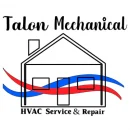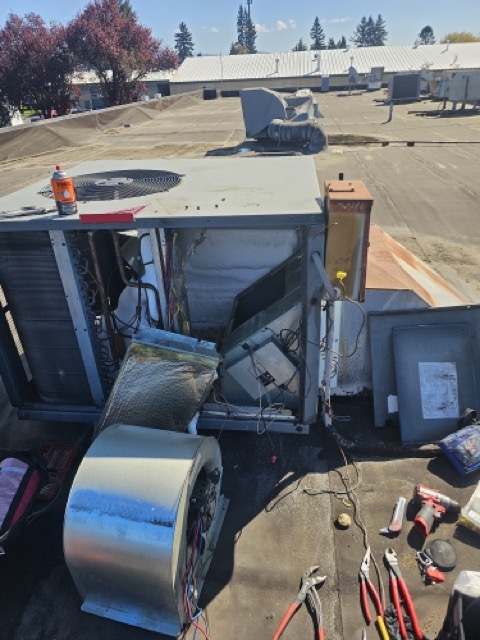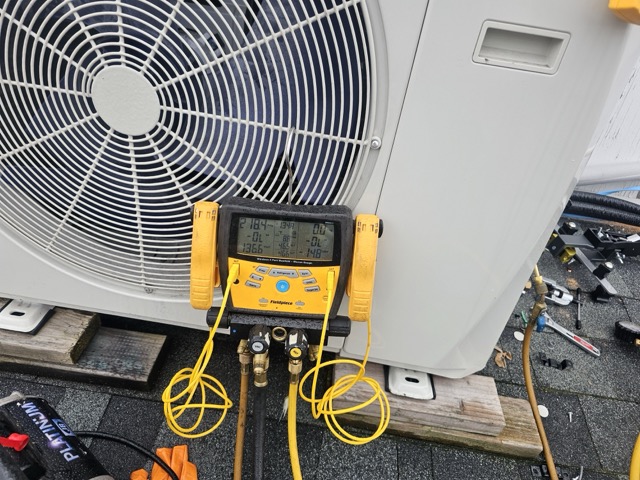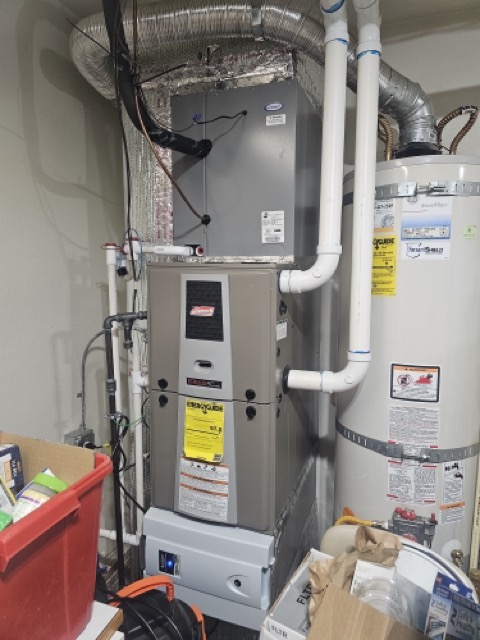What to Expect During a Commercial HVAC System Upgrade
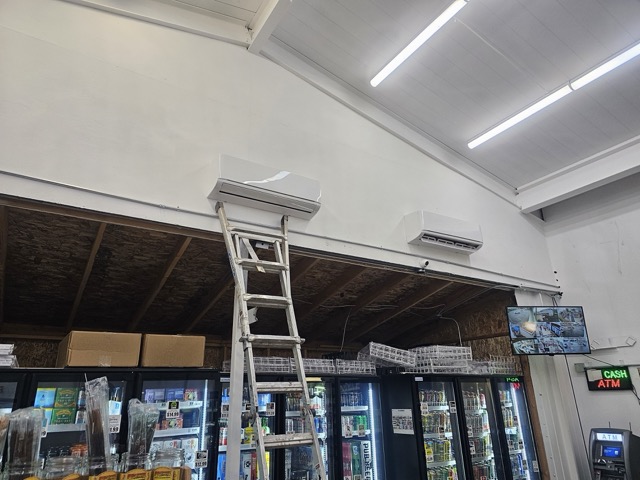
Don't Be Surprised with Commercial HVAC Upgrades
Your commercial HVAC system is one of the hardest-working components of your building. From keeping employees and customers comfortable to ensuring critical equipment stays within safe operating temperatures, it plays an essential role in day-to-day business operations. But like all mechanical systems, HVAC units have a limited lifespan—and when they start to wear down, it’s not just comfort at stake.
Rising utility costs, frequent breakdowns, and uneven climate control can all signal it’s time to upgrade. For many business owners, the thought of upgrading their commercial HVAC system can seem overwhelming. What does the process involve? How long will it take? Will it disrupt operations?
This guide walks you through everything you need to know about upgraded commercial heating or AC installation—from signs it’s time to replace it to what the installation process looks like, and how to minimize downtime during the transition.
How Seasonal Changes Strain Outdated Systems
It’s important to understand how the seasons can magnify existing HVAC problems—another reason to consider an upgrade. Commercial HVAC systems must adapt to dramatic changes in temperature, humidity, and air quality throughout the year.
In winter, older systems may struggle to maintain consistent warmth, leading to cold drafts and higher energy bills as the unit overcompensates. In summer, these same systems often run continuously, causing strain on parts, increased wear, and higher risk of mid-season failure. If your system can’t adapt to these seasonal changes efficiently, you’re wasting energy and risking downtime.
Modern HVAC units are designed to operate more dynamically, adjusting to seasonal loads and varying occupancy levels. This not only reduces energy use but also improves overall comfort.
Why It Might Be Time to Upgrade
Before diving into the upgrade process, it’s important to understand the reasons behind making such a significant investment. While repair may be suitable for some issues, there comes a point when replacement makes more financial and operational sense.
Age of the System
Most commercial HVAC systems have a functional lifespan of 15–20 years, depending on usage and maintenance. If your system is nearing this age or older, it’s likely not operating at peak efficiency—even if it’s still running. Older units often lack modern energy-saving features and may struggle to keep up with current building demands.
Frequent Repairs and Downtime
If you’re calling your HVAC technician more often than your accountant, it may be time to consider a new system. Frequent repairs are not only costly, but they also disrupt business operations. An unreliable system can lead to lost productivity, customer discomfort, and even equipment damage.
Rising Energy Bills
As HVAC systems age, they often consume more energy to deliver the same level of heating or cooling. Upgrading to a modern, high-efficiency system can reduce energy costs significantly. Many newer systems come with energy-saving technologies, such as variable-speed fans and smart thermostats, that help control utility expenses.
Changing Building Requirements
Your building may have evolved over time—added square footage, more employees, higher tech demands, or different occupancy patterns. A system designed for your facility ten years ago may not meet your needs today, especially when dealing with changing seasonal loads.
Uneven Temperature and Comfort Issues
If you’re constantly hearing complaints about hot spots, cold spots, or stuffy air, your system could be struggling to distribute air evenly. Upgrading can restore proper airflow and climate control throughout the building.
Planning for the Upgrade: What to Expect
Once you’ve decided it’s time to upgrade, the process typically follows a series of steps. Working with a reputable HVAC contractor is key to ensuring everything runs smoothly.
Site Assessment and Load Calculation
Before selecting a heating or AC replacement, your HVAC contractor will perform a detailed site assessment. This includes evaluating your building’s size, layout, insulation, number of occupants, equipment heat loads, and even sun exposure. Based on this data, they’ll conduct a load calculation to determine the heating and cooling capacity your system requires.
This step ensures your new HVAC system is properly sized—not too big (which wastes energy) or too small (which leads to strain and underperformance).
System Selection and Design
Your contractor will then help you choose the best system for your building and budget. Common commercial HVAC system types include:
- Rooftop Units (RTUs): Common in retail and office settings, these units house all components in one cabinet and are installed on the roof.
- Split Systems: These feature separate indoor and outdoor units and are ideal for multi-zone buildings.
- VRF/VRV Systems: Variable Refrigerant Flow systems allow for independent temperature control in different areas and are highly efficient.
- Chillers and Boilers: Often used in large buildings or campuses, these systems manage centralized heating and cooling.
You’ll also have the option to integrate advanced features such as:
- Smart thermostats and control.
- Zoning systems for different areas of the building
- Enhanced filtration or air purification for improved indoor air quality
Planning and Scheduling
Once the system has been selected, your contractor will work with you to plan the installation timeline. For businesses, minimizing disruption is a top priority. Installation is often scheduled outside of normal business hours, during weekends, or in stages to maintain partial system operation.
Permits may be required depending on local codes and the scope of work, and your contractor should handle the paperwork and coordination.
During the Installation
The installation process can range from one day to several weeks, depending on the complexity and size of the system. Here’s what to expect:
1. Removal of Old Equipment
Your existing equipment will be carefully disconnected and removed. This includes not just the primary HVAC units but also any related ductwork, wiring, or piping that needs to be upgraded.
2. Installation of New System
New equipment is then installed according to your building’s layout and the system design. This may include setting rooftop units in place, installing new ductwork, running refrigerant lines, or wiring smart controls.
3. System Testing and Balancing
Once the system is physically installed, technicians will test all components to ensure they function correctly. This includes:
- Checking refrigerant levels
- Testing airflow in each zone
- Verifying thermostat operation
- Ensuring all safety systems (such as high-limit switches and pressure sensors) work properly
The system will also be “balanced,” meaning airflow will be adjusted to ensure each area of the building receives the correct amount of heating or cooling.
4. Staff Training and Handover
If your building maintenance staff will be managing the system, your HVAC contractor should provide basic training. This includes:
- How to use the control system or thermostat
- What warning signs to look for
- How to schedule filter changes or inspections
You should also receive documentation, warranty information, and maintenance schedules.
After Installation: Maintenance Is Still Key
A brand-new commercial HVAC system is a major investment—and like any investment, it needs care to keep it operating efficiently. This is where preventative maintenance becomes critical.
Benefits of Ongoing Maintenance Post-Upgrade:
- Protects Your Investment: Regular HVAC maintenance extends the lifespan of your new system.
- Avoids Disruption: Scheduled checkups catch minor issues before they become emergencies that interrupt business.
- Ensures Safety: Maintenance ensures that no loose electrical components, clogged drain lines, or ventilation blockages go unnoticed.
- Preserves Warranty: Many manufacturers require regular maintenance to keep warranty coverage valid.
Establishing an HVAC maintenance plan with your provider ensures your new system continues performing at its best year-round, adapting smoothly to seasonal changes and operational demands.
How to Prepare Your Business for an HVAC System Upgrade
While your HVAC contractor will handle the bulk of the technical work, there are several steps you can take as a business owner or facility manager to ensure a smooth installation and reduce any disruption to your operations. Proper preparation can help minimize downtime, maintain safety, and keep your team informed during the upgrade process.
Communicate with Staff and Tenants
If your facility is occupied—whether by employees, tenants, or customers—be sure to communicate the schedule of the upgrade in advance. Let them know when the work will begin, how long it may last, and if any temporary temperature fluctuations or access limitations are expected. Providing clear information helps reduce complaints and ensures cooperation during the installation.
Coordinate with Your Contractor
Work closely with your HVAC contractor to plan the installation at the least disruptive times. If your business operates primarily during weekdays, consider weekend or overnight work. For buildings with multiple zones, ask if installation can be completed in phases so parts of the building remain operational throughout.
Protect Equipment and Sensitive Areas
During an HVAC upgrade, dust and debris may be stirred up, especially if ductwork or ceiling access is involved. Take precautions by covering sensitive equipment, electronics, or merchandise. If you’re in a facility like a medical office or data center, you may need to isolate critical areas temporarily.
Plan for Temporary Climate Control (If Needed)
In some cases, particularly during extreme heat or cold, you may need temporary cooling or heating solutions while the new system is being installed. Discuss options for portable units or temporary zoning with your HVAC provider.
Financing and Incentives: Making the Upgrade More Affordable
Upgrading your commercial HVAC system is a significant investment—but one that pays off in comfort, efficiency, and operational stability. Still, the initial cost can be a concern. Fortunately, there are several financial options and incentives available to help offset the expense.
Energy-Efficiency Rebates and Tax Credits
Many utility companies and government programs offer rebates for installing energy-efficient commercial HVAC equipment. Depending on your location and the system you choose, these rebates can cover a meaningful portion of the total cost. Federal tax credits or deductions for commercial energy efficiency improvements may also apply.
Financing and Leasing Options
If paying the full cost upfront isn’t feasible, many HVAC contractors or third-party lenders offer financing or leasing programs. This allows you to spread the cost over time, often with low interest rates or flexible payment terms.
Long-Term ROI
Don’t forget the long-term return on investment: lower monthly utility bills, reduced repair costs, fewer disruptions, and improved tenant or employee satisfaction. Over the life of the system, these savings often surpass the initial cost of the upgrade.
Consult your HVAC contractor to explore which programs or rebates are available in your area. Taking advantage of these opportunities can make the upgrade more accessible and financially beneficial for your business.
A Smart Step Toward Efficiency and Reliability
Upgrading a commercial HVAC system may seem like a daunting process, but with careful planning, the right contractor, and a clear understanding of your building’s needs, it becomes a strategic investment in your business’s future.
You’ll gain a system that’s safer, more reliable, and energy-efficient, reducing both operating costs and risk of downtime. You’ll also create a healthier, more comfortable space for employees and customers—something that’s more important than ever in today’s workplace.
Whether your system is simply aging, struggling with seasonal changes, or no longer meeting your building’s demands, now is the time to consider the benefits of an upgrade. Partner with a trusted HVAC expert who understands commercial systems, and you’ll set your business up for years of efficient, uninterrupted comfort.
A Top Rated HVAC Contractor



